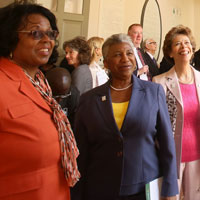In 1994 during the construction of the Kontos building on East Marshall Street in Richmond, Va., a well was discovered during excavation at the northeast corner of what had been historically known as Academy Square. Human remains and artifacts were removed from the well. Although covered by the media in 1994, the discovery remained largely unaddressed until awareness of the well’s history was included in Dr. Shawn Utsey’s documentary, “Until the Well Runs Dry,” which examined the issue of grave robbing and use of black cadavers in medical education during the 19th century.
In the News

An international association devoted to the study of the African diaspora comes to Williamsburg this fall, in observance of the 400th year since the arrival of the first Africans in British North America and the origins of American slavery.

W&M News recently talked with Robert Trent Vinson, Frances L. and Edwin L. Cummings Professor of History and Africana Studies, about 1619, its significance and its part in the upcoming ASWAD conference.

Understanding the legacy of the African arrival is crucial to comprehending our trajectory as a country, and the critical role of cultural diversity in American life.

In August 1619, two milestone events happened in Jamestown, the first permanent colony in English North America.

A small African-American community has existed less than 10 miles from the president’s former plantation for generations. Only recently has the full extent of their relationship been revealed.

Lemon Project Director Jody Allen discusses the history of the project, its accomplishments and its goals for the future.

The University of Cambridge will conduct a two-year academic study of how much it benefited from the Atlantic slave trade and whether its scholarship reinforced race-based thinking during Britain’s colonial era.

A concept has been selected for the Memorial to African Americans Enslaved by William & Mary, President Katherine A. Rowe told the university’s Board of Visitors today.

Continuing its powerful work in chronicling William & Mary’s history, the Lemon Project hosted its ninth annual spring symposium, “Celebrating Legacies, Constructing Futures: Four Hundred Years of Black Community and Culture,” on campus March 14-16.

The event, titled “Celebrating Legacies, Constructing Futures: Four Hundred Years of Black Community and Culture,” will include a meeting of the Universities Studying Slavery consortium and a keynote address by Christy Coleman, chief executive officer of the American Civil War Museum, along with multiple panel discussions.

Just outside Charlottesville, Va., the roads lose their markings as they wind through the woods, passing an occasional church, a cemetery and a plantation known as Highland, owned by America's fifth president James Monroe.

A competition is being launched today to solicit conceptual ideas for a Memorial to African-Americans Enslaved by William & Mary.

Two plaques, one honoring African-Americans and the other recognizing women, were unveiled and dedicated Thursday afternoon during a ceremony held at what many consider the most important building on campus.

As the long-term Lemon Project effort prepares for the next chapter, a Board of Visitors resolution apologizes for W&M’s history of owning slaves and racial discrimination.

William & Mary has been celebrating the 50th anniversary of its first African-American students in residence throughout the 2017-2018 academic year.

Giovanni, a distinguished university professor at Virginia Tech who has authored more than 27 poetry collections, urged her audience to acknowledge that the first slaves played a crucial, often ignored, part in the formation of America.

William & Mary will host the 10th Biennial Conference of the Association for the Study of the Worldwide African Diaspora Nov. 5-10, 2019, in the Williamsburg Lodge.

In August 1619, two milestone events happened in Jamestown, the first permanent colony in English North America.

Historians discussed the arrival of the first African slaves to Virginia in 1619 and their encounters and cultural exchanges with Native Americans and English settlers. The John W. Kluge Center at the Library of Congress, the Middle Passage Project of William & Mary and the Virginia Commonwealth’s 2019 Commemoration co-hosted the symposium.

The John W. Kluge Center at the Library of Congress will convene a symposium, titled “1619 and The Making of America,” that will bring together respected scholars to explore the intricate encounters of Africans, Europeans and native people during this significant period in America’s history.

Thomas Jefferson Award 2018 honoree Joanne Braxton, the Kluge Center’s David B. Larson Fellow in Health and Spirituality, will be joined by W&M Associate Professor Robert Trent Vinson and Cassandra Newby-Alexander Ph.D. ’92, director of the Roberts Center for African Diaspora Studies at Norfolk State University, to discuss “1619 and The Making of America.” This free, public event is Feb. 23 at the Library of Congress’ Thomas Jefferson Building in Washington, D.C.

"15,000 ancestors of African-America left their whole bodies to mark time for nearly 300 years. The discovery of this burial ground in downtown Manhattan materially confronted us with a decision: whether to realize our capacity to disregard these remains, sanctify them, or restore their stories to memory, whichever advocacy was the most powerful."














